A comprehensive exploration of the Indian crypto market: Web3 achieves fertile ground for "sighting" data

Reprinted from panewslab
03/23/2025·2MAuthor: Tiger Research
Compiled by: Felix, PANews
TL;DR
- Key development areas for Web3 projects: India has a population of 1.4 billion (median age 28), 9.75 million developers, over 1,200 projects and $3 billion investment, providing the best conditions for the scale required to achieve the development of the Web3 ecosystem.
- Regulatory uncertainty is the main obstacle: including a fixed tax rate of 30%, a 1% withholding tax, a lack of specialized regulatory agencies, and complex jurisdictional issues
- Develop strategies at different stages: Successful entry into the market requires guiding Web3-friendly users (local language support, regional marketing), and then discovering builders (can work with local investors), and finally expanding to partnerships with governments and enterprises
1. Why you need to understand the Indian market
New projects are constantly emerging in the Web3 market, and the most important thing about these projects is "data". Data ultimately represents users, builders and investors involved in the ecosystem, and many projects are working to create this data. In a large number of new projects, verifiable data is particularly important for attracting attention. Asia, especially India, is a central region that produces real and meaningful data.
India's first advantage is its young population. The median age in India is about 28 years old, with a larger younger population than in Indonesia (30) or Vietnam (32). This population group showed a quick acceptance and enthusiasm for new technologies. The second advantage is the huge population. With over 1.4 billion people, India currently holds cryptocurrency, providing huge potential for Web3 technology expansion. The third advantage is development capabilities. India has several excellent engineering universities and about 9.75 million developers who have demonstrated outstanding development capabilities through successful Web3 projects such as Polygon.
India is the best region for producing the critical “data” needed today, and many projects have entered India and achieved fruitful results. However, like all regions, India has disadvantages. Hashed Emergent, a India-based Web3 venture capital firm, has prepared the Indian market report, providing a "green book" for entry into the Indian market.
2. Main summary of Hashed Emergent report
2.1. Web3 ecosystem
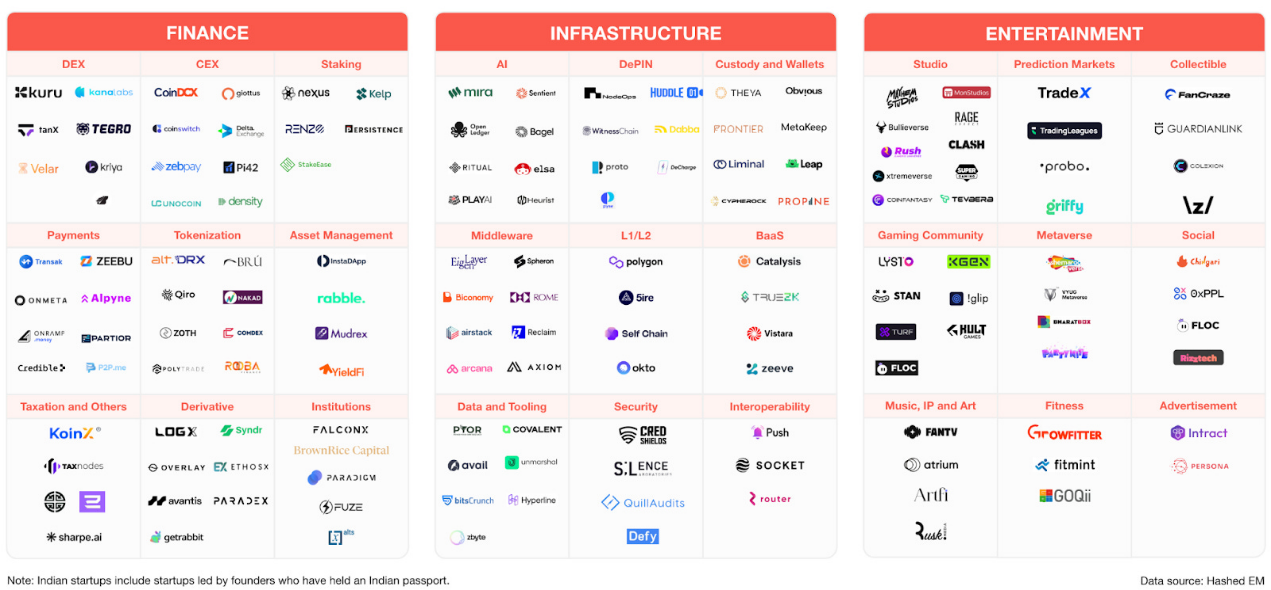
India has established an extensive Web3 ecosystem with more than 1,200 projects operating in various fields. To date, India’s Web3 startups have attracted over $3 billion in total investment, with growth particularly strong in 2024, receiving $564 million in investment, more than double the amount in 2023.
According to investment areas, infrastructure is the most attractive, followed by finance. In contrast, investment in the entertainment industry has dropped significantly. In the popular infrastructure sector, the Indian founder who has gained a foothold overseas has made a significant contribution. They have developed globally competitive services such as Eigen Layer, Sentient and Avail, attracting a large amount of investment funds.
Recently, emerging fields such as DePIN and BaaS (Blockchain as a Service) have also attracted the attention of investors. These trends suggest that investors are actively exploring the possibility of applying decentralized technologies to various industries.
Especially for industries suitable for the AI era, AI-based infrastructure, middleware and data tools are becoming key investment areas. In the local market, major venture capital firms including Hashed Emergent and Polygon are actively involved in nurturing and investing in India’s Web3 ecosystem.
2.2. Consumers and enterprises adopt
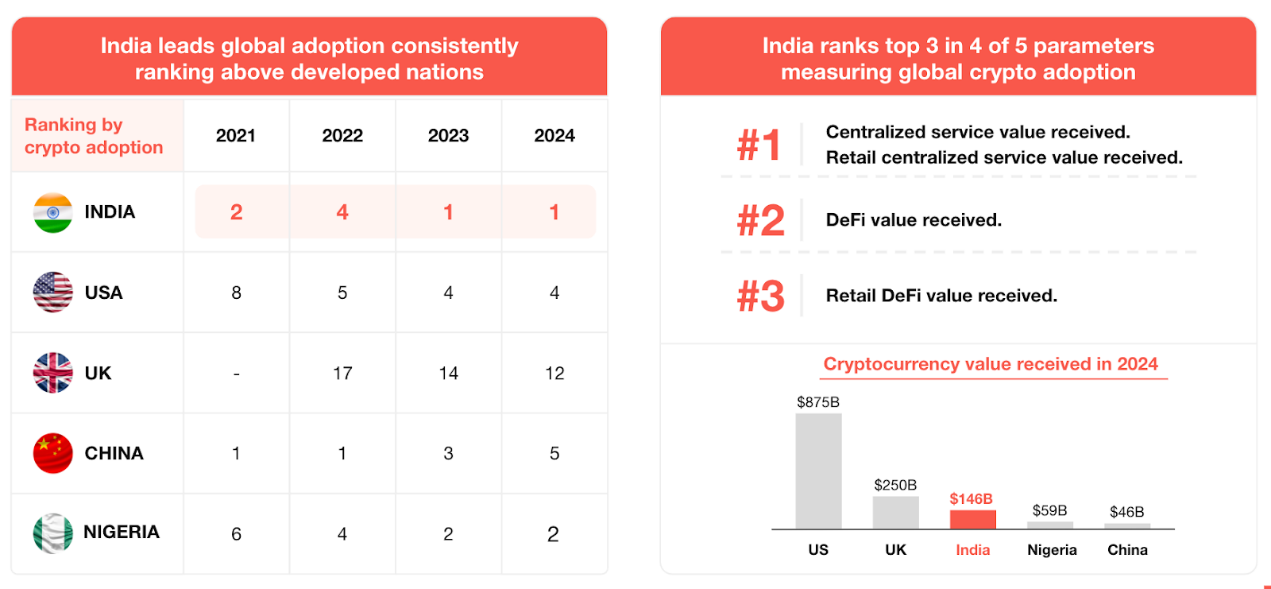
Since 2023, the Indian crypto investment market has shown a clear recovery trend. It ranks first in Chainalysis's cryptocurrency adoption index and earns high scores in both the CEX and DEX fields.
45% of retail investors’ portfolios are blue chip cryptocurrencies with reliable stability. It is worth noting that compared with other crypto assets, the transaction volume of meme coins has increased by five times. This shows that the investment preferences of retail investors are changing.
By age, people aged 27-40 dominate token investments with higher income and market awareness. It is worth noting that investors in their 40s have three times the per capita investment amount that other age groups have. Generation Z accounts for 35% of all crypto investors and plays an important role in market expansion.
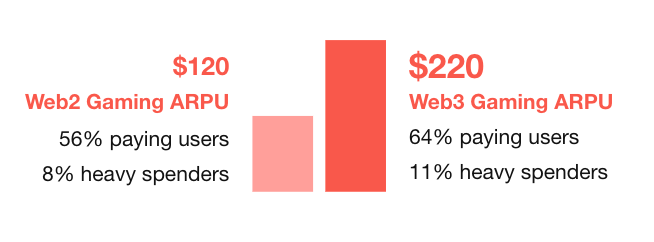
The Web3 gaming market in India is growing by ensuring a Gen Z-centric user base. In particular, 50% of gamers are under 25 years old, indicating that young people can quickly adapt to the new game mode. Web3 games have a per capita user income (ARPU) of $220, which is much higher than Web2 games' $120.
In Web3 games, the proportion of paid users reaches 64%, and the proportion of high-consumption users reaches 11%, with a revenue structure better than Web2 games (56% and 8% respectively). In addition, 38% of traditional gamers have experienced Web3 games, and 60% of them choose to continue to participate.
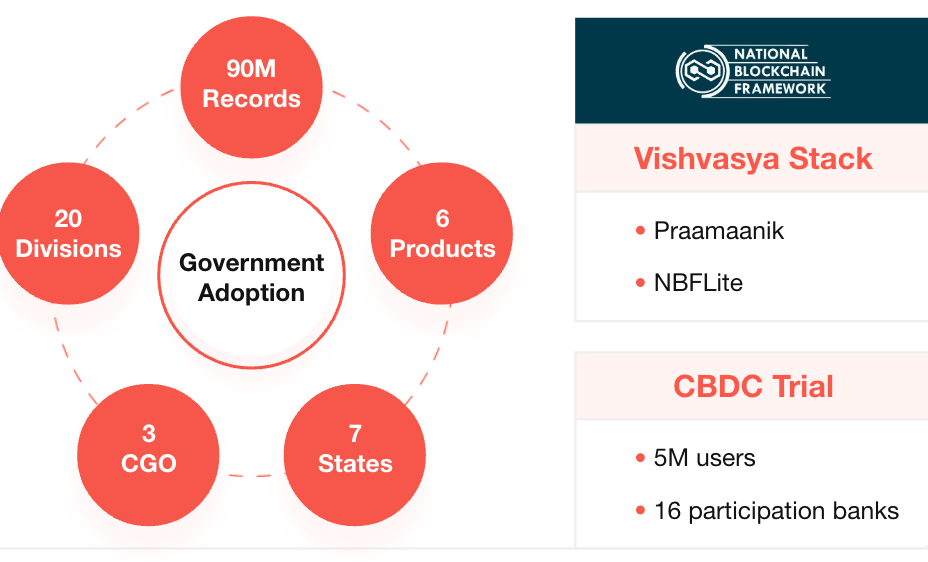
The government has taken positive measures to create a national blockchain framework. The framework aims to improve the security and transparency of citizens’ use of services. Key components include the “Vishvasya” blockchain-as-a-service platform, the “NBFLite” sandbox for rapid research by startups and universities, the “Praamaanik” for verifying the authenticity of mobile applications, and the National Blockchain Portal. In addition, the CBDC pilot project led by the Reserve Bank of India (RBI) gathers 5 million users of 16 banks to use blockchain technology to test new payment methods.
2.3. Developer ecosystem
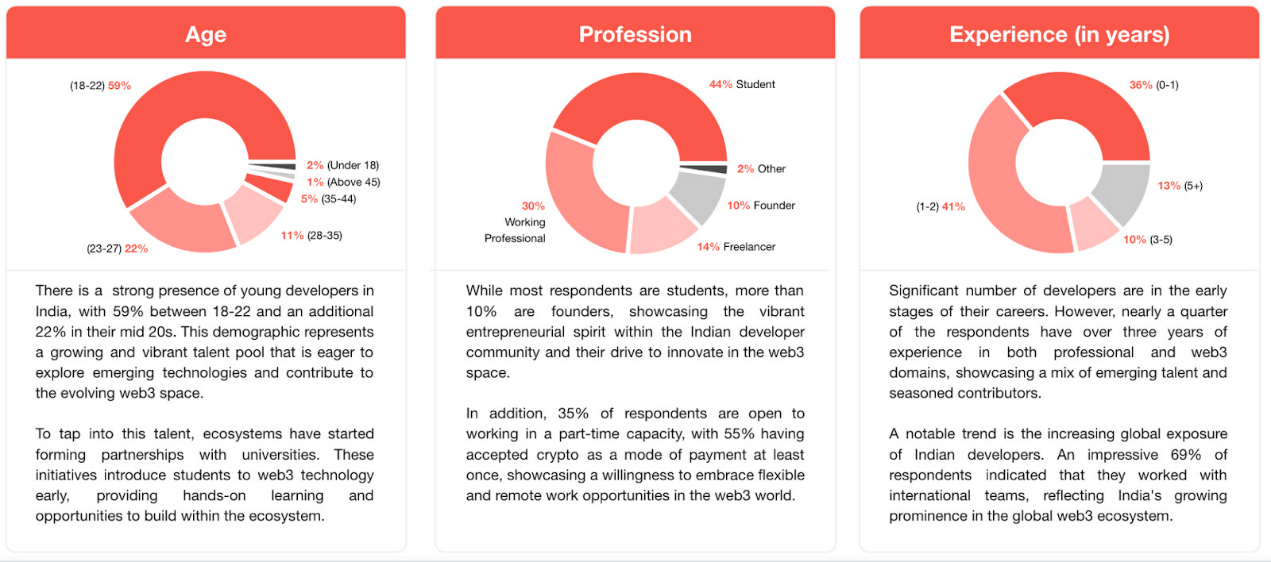
India has become a global hub for entrepreneurs and developers, leading innovation in a variety of Web3 fields. It has become the largest developer market, accounting for 12% of the global cryptocurrency developer community.
According to a survey of more than 500 developers, India's Web3 ecosystem is growing rapidly with young talents, entrepreneurial vitality and growing global exposure. Through university partnerships and flexible working models, an ecosystem that supports its growth has been formed.
Despite the growing global exposure of developers, 51% say their salary does not meet global standards.
Hackathons and developer communities have become key elements of the development of the Web3 ecosystem in India. These platforms provide developers with hands-on experience, guidance, financing opportunities and global exposure. As participation rates increase, the growth trajectory of next-generation developers is taking shape.
2.4. Supervision, taxation and policy
India's Web3 industry is currently in a transition period of rapid changes in regulatory and tax policies. Strong government regulatory measures and high tax rates have limited market development, so policies need to be adjusted to support industry development.
Starting from 2023, the Indian government will comprehensively strengthen anti-money laundering regulations and improve the transparency of the virtual asset market. All Virtual Asset Service Providers (VASPs) must be registered under the Anti-Money Laundering Act and must implement customer identification procedures, maintain transaction records and designate dedicated Anti-Money Laundering Officers.
By the end of 2024, regulatory tightening will become increasingly obvious. The Indian government has taken extreme measures to completely block access to foreign crypto exchanges that do not comply with local regulations. This action clearly shows that compliance is a necessary condition for entering the Indian market.
Tax policies have also undergone revolutionary changes. The 2025 Fiscal Act has established a mandatory reporting system for crypto asset transactions and user information through the adoption of the international standard OECD crypto asset reporting framework. In addition, the legal definition of virtual digital assets is expected to expand to a more comprehensive concept of “crypto assets”.
The current tax structure puts a heavy burden on the industry. Crypto investment profits are subject to a high fixed tax rate of 30%, without any cost deductions, and all individual transactions are subject to a 1% withholding tax. This tax burden severely limits market liquidity.
The lack of dedicated Web3 regulators raises another problem. Regulatory ambiguity regarding virtual asset classification and decentralized protocol processing remains as multiple agencies exercise overlapping jurisdictions. From opening a bank account to using payment services, Web3 companies face difficulties in accessing basic financial infrastructure, with many exchanges restricting withdrawal of cryptocurrencies, preventing users from self-custody choices.
In order to achieve sustainable development in India, a regulatory framework for Web3 is urgently needed to reduce tax burdens, improve access to financial services, and conduct reasonable supervision of non-custodial services such as asset self-custody.
3. India is about to usher in a breakthrough
Overall, India has formed a mature ecosystem with a mature industry and user base, but the core issue lies in the chaos in government regulation. Although the above macro factors are generally favorable, a mature regulatory framework required for regional ecosystem development has not yet been established. Despite positive results from the government-led blockchain program, the lack of dedicated regulators and overlapping jurisdictions has created uncertainty in the outside world.
In a changing global regulatory environment, this chaos greatly reduces market appeal. This is the biggest obstacle for investors and businesses to enter the market and needs to be solved quickly.
Entering the Indian market requires a phased strategy. First, users with high Web3 adaptability should be given priority. Indian users have a deep understanding of Web3 and are huge in number, so they can produce effective results through successful user guidance. This requires supporting the local language while hiring local personnel or working with marketing agencies to understand local marketing and business structures.
Secondly, development can be carried out for builders. At this stage, direct connections with investors such as Hashed Emergent become important. Local agencies alone have limitations in supporting builders and lack sufficient expertise.
Finally, it can be extended to cooperation with governments and enterprises. Despite some confusion caused by the government, it has established a national blockchain framework and achieved tangible results. Strategic cooperation can ensure a leading position in driving market change.
Related Readings: South Korea's Crypto Escape: The Outflow of Capital, Enterprises and Talent

